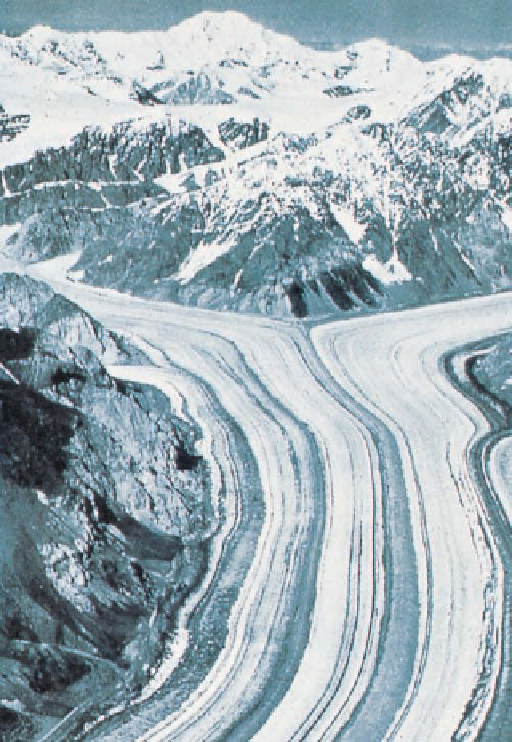Geology Reference
In-Depth Information
channels as sand and gravel bars. The vast blanket of sedi-
ment so formed is an
outwash plain
.
Valley glaciers also discharge large amounts of meltwater
and, like continental glaciers, have braided streams extending
from them. However, these streams are confi ned to the lower
parts of glacial troughs, and their long, narrow deposits of
stratifi ed drift are known as
valley trains
(
◗
Figure 14.16
Types of Moraines A moraine is a mound or ridge
of unstratifi ed till. The types shown here—lateral, medial, and end
moraines—are defi ned by their position.
Figure 14.18a).
Outwash plains, valley trains, and some moraines com-
monly contain numerous circular to oval depressions, many
of which contain small lakes. These depressions are
kettles
that form when a retreating glacier leaves a block of ice that
is subsequently partly or wholly buried (Figures 14.17 and
14.18b). When the ice block eventually melts, it leaves a
depression; if the depression extends below the water table,
it becomes the site of a small lake. Some outwash plains have
so many kettles that they are called
pitted outwash plains.
◗
Kames and Eskers
Kames
are conical hills of stratified
drift up to 50 m high (Figure 14.17 and
a
Lateral moraine and end moraine deposited by a glacier on Baffi n
Island in Canada.
Figure 14.19a).
Many form when a stream deposits sediment in a depression
on a glacier's surface; as the ice melts, the deposit is lowered
to the land surface. Kames also form in cavities within or
beneath stagnant ice.
Long sinuous ridges of stratifi ed drift, many of which
meander and have tributaries, are
eskers
(Figures 14.17
and 14.19b). Most eskers have sharp crests and sides that
slope at about 30 degrees. Some are as high as 100 m and
can be traced for more than 500 km. The sorting and
stratification of the sediments in eskers clearly indicate
deposition by running water. The features of ancient eskers
and observations of present-day glaciers show that they form
in tunnels beneath stagnant ice. Excellent examples of eskers
can be seen at Kettle Moraine State Park in Wisconsin and
in several other states, but the most extensive eskers in the
world are in northern Canada.
◗
Medial
moraine
Some lakes in areas of glaciation formed as a result of glaciers
scouring out depressions; others occur where a stream's
drainage was blocked; and others are the result of water
accumulating behind moraines or in kettles. Regardless of how
they formed, glacial lakes, like all lakes, are areas of deposition.
Sediment may be carried into them and deposited as small
deltas, but of special interest are the fine-grained deposits.
Mud deposits in glacial lakes are commonly fi nely laminated
(having layers less than 1 cm thick) and consist of alternat-
ing light and dark layers known as
varves
(
Lateral
moraine
Figure 14.20a),
which represents an annual episode of deposition. The light
layer formed during the spring and summer and consists of
silt and clay; the dark layer formed during the winter when
the smallest particles of clay and organic matter settled from
suspension as the lake froze over. The number of varves indi-
cates how many years a glacial lake has existed.
Another distinctive feature of glacial lakes with varves
is
dropstones
(Figure 14.20b). These are pieces of gravel,
some of boulder size, in otherwise very fine-grained de-
posits. The presence of varves indicates that currents and
◗
b
Lateral and medial moraines on the Bernard Glacier in the St. Elias
Mountains in Alaska.
during the coldest months. This meltwater forms a series of
braided streams that radiate out from the front of continen-
tal glaciers over a wide region. So much sediment is supplied
to these streams that much of it is deposited within their




Search WWH ::

Custom Search